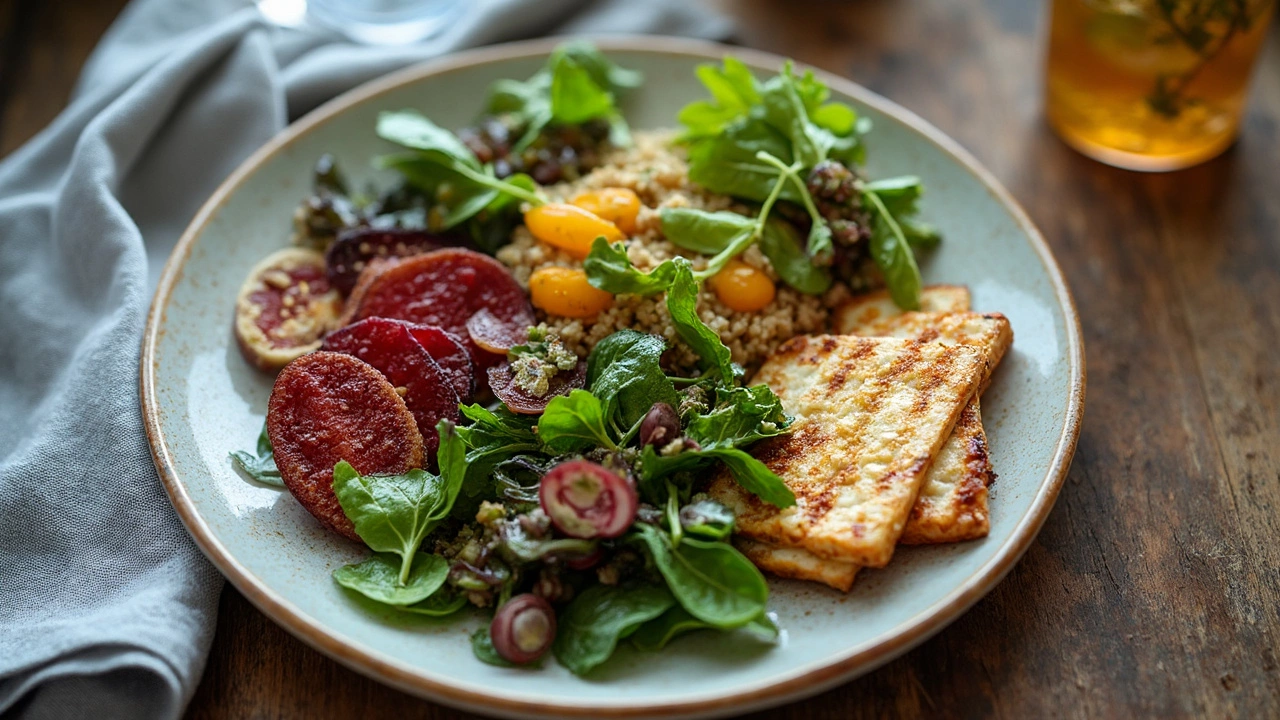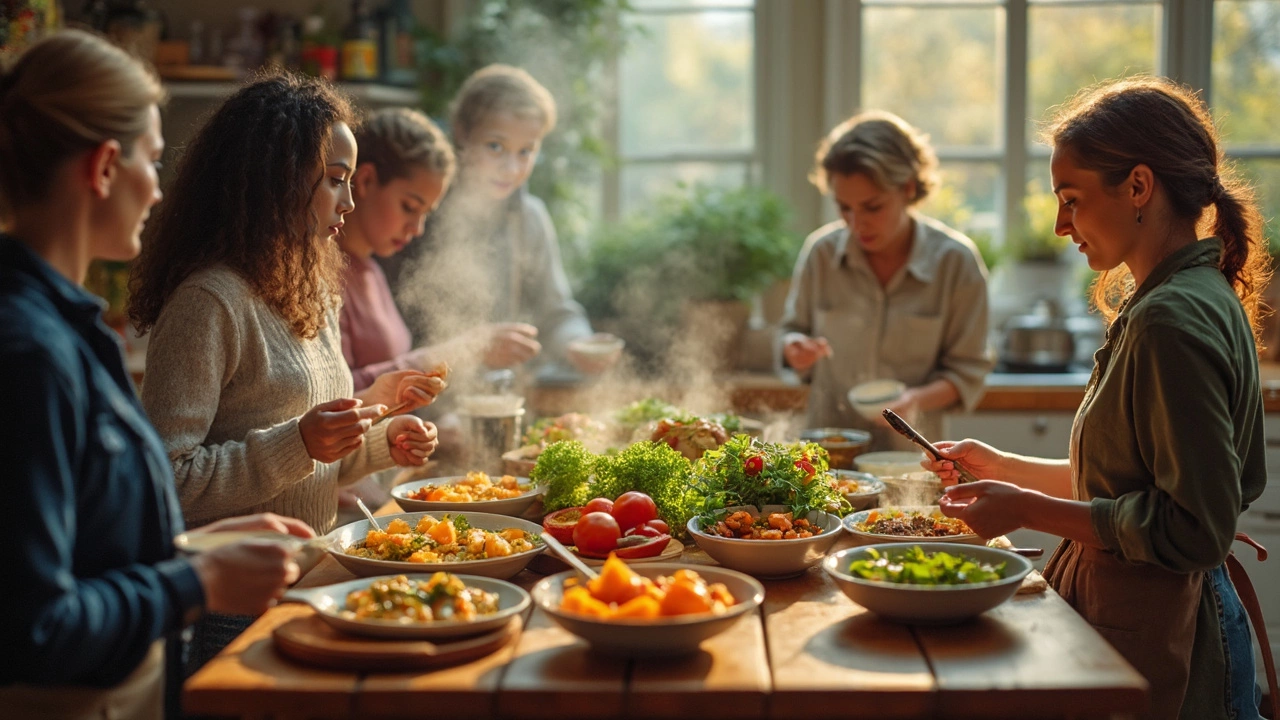The search for the best vegetarian meal isn’t about finding the fanciest recipe out there—it’s about finding something satisfying that hits the spot every time. Protein? Check. Flavor? Absolutely. Nutrition? No brainer. If a meal is appetizing, simple to make, and keeps you full, that's a winner.
If you're always stuck on what to cook, try thinking in terms of building blocks: start with a base (like lentils, beans, or chickpeas), add roasted veggies, and toss in bold sauces or toppings. Even skeptics won’t miss meat when the meal packs texture, freshness, and a bit of crunch.
- What Makes a Vegetarian Meal Great?
- Flavor Powerhouses Every Vegetarian Should Know
- Balancing Nutrition Without Meat
- Easy Meals You’ll Actually Crave Tonight
What Makes a Vegetarian Meal Great?
If you ever finished a salad and felt hungry again an hour later, you know not every veggie plate fits the bill. The best vegetarian meal doesn’t just skip the meat—it should fill you up, taste awesome, and deliver all the good stuff your body needs. Here’s what separates an okay meal from one you’ll actually look forward to eating.
- Protein: This is key. Beans, tofu, lentils, and seeds aren’t just backup—they’re the stars. Your meal should have at least 15 grams of protein if you want to stay energized. Chickpea curry, black bean tacos, or a tofu stir-fry? Count those in.
- Fiber: Plants are naturally full of fiber, which keeps you full and your digestion running smoothly. Look for whole grains like brown rice or quinoa, plus plenty of veggies.
- Flavor: Spices, herbs, sauces, and a splash of something tangy (think lemon or vinegar) can turn a boring dish into something craveable. No one wants bland.
- Color: If your bowl looks like a rainbow, you’re probably getting a range of nutrients. Different colors in fruits and veggies mean different vitamins and antioxidants.
- Balance: Mix up textures—creamy, crunchy, juicy, chewy. It makes each bite interesting and satisfying.
If you’re curious about what you actually get from a typical vegetarian meal, check out this comparison of common plant-based proteins:
| Protein Source | Protein (per cooked cup) | Calories | Fiber |
|---|---|---|---|
| Lentils | 18g | 230 | 15g |
| Chickpeas | 15g | 269 | 13g |
| Firm Tofu | 20g | 176 | 2g |
| Black Beans | 15g | 227 | 15g |
| Quinoa | 8g | 222 | 5g |
Want a simple way to build the best vegetarian meal? Start with protein, pile on veggies, add a grain for staying power, and finish with a zippy sauce. That way you’ll actually look forward to sitting down at the table.
Flavor Powerhouses Every Vegetarian Should Know
If you think vegetarian food means bland veggies and boring salads, you just haven’t loaded up on the right flavor boosters yet. Real talk: a best vegetarian meal is only as good as what you put into it. The magic comes from adding the stuff that makes your taste buds do a happy dance.
Here’s what actually brings food to life, and how vegetarians can use these game-changers:
- Spices and Herbs: Cumin, smoked paprika, turmeric, basil, fresh cilantro—these aren’t fancy, they’re just straight-up essential. A splash of lime with chili powder on roasted sweet potatoes? Next level.
- Umami Bombs: Mushrooms, sun-dried tomatoes, soy sauce, miso paste, and nutritional yeast all make veggies taste meaty without a scrap of meat. Crave cheesy flavor? Sprinkle nutritional yeast on pasta or popcorn.
- Fermented Goodness: Kimchi, sauerkraut, and pickled onions are easy to toss on bowls or sandwiches for that tang and crunch.
- Toasted Nuts & Seeds: A handful of pumpkin seeds or toasted almonds add crunch and richness, plus healthy fats. Even a spoon of tahini or nut butter jazzes up a simple dish.
- Bold Condiments: Sriracha, harissa, pesto, or a solid vinaigrette pull a plain bowl together. Don’t forget hummus for dipping or smearing—it’s not just for pita chips.
Ever notice how global cuisines with killer vegetarian dishes all use a bunch of these? Indian curries, Thai stir-fries, and Middle Eastern mezze plates aren’t born bland—they get layered flavor from these basics.
| Category | Examples | Use For |
|---|---|---|
| Herbs & Spices | Cumin, basil, turmeric, coriander | Soups, curries, veggie roasts |
| Umami Sources | Miso, soy sauce, nutritional yeast | Stir-fries, sauces, risottos |
| Fermented Foods | Kimchi, pickled onions, sauerkraut | Bowls, sandwiches, salads |
| Nuts & Seeds | Pumpkin seeds, cashews, tahini | Salads, grain bowls, dips |
| Condiments | Pesto, hot sauce, hummus | Toppings, dips, marinades |
Here’s an easy way to make any dish pop: take five minutes to add one punchy sauce, herb, or crunchy element before you eat. That’s how you go from “meh” to “wow” fast. Bonus tip—keep a few of these staples in your fridge and pantry so you’re always set to amp up any meal, no matter what’s cooking.

Balancing Nutrition Without Meat
If you're skipping meat, the main challenge is making sure your plate covers all the nutrition bases. You don’t want to feel tired or get stuck with boring meals. It’s not as tough as it sounds—all you need is a little know-how and a habit of paying attention to what goes into your meals.
Let’s start with protein. It’s the number one thing people worry about, but plant foods like lentils, chickpeas, tofu, tempeh, and quinoa deliver plenty. As a rough guide, a cup of cooked lentils has about 18 grams of protein, which is close to what you'd get from beef or chicken. Here’s a quick look at some popular vegetarian sources of protein:
| Food | Protein per 1 cup (cooked) |
|---|---|
| Lentils | 18g |
| Chickpeas | 15g |
| Black beans | 15g |
| Tofu | 20g |
| Quinoa | 8g |
Here’s the other catch: there’s more to nutrition than just protein. Iron, vitamin B12, zinc, omega-3s, and calcium matter too. Most plants don’t have B12, so grabbing a supplement or eating fortified foods (like breakfast cereals or plant milks) is smart. For iron and zinc, foods like beans, nuts, seeds, and dark leafy greens help a lot, and eating them with a source of vitamin C (think: squeeze of lemon, some bell peppers) helps your body use the iron better.
Worried about omega-3s? Toss some chia seeds, ground flaxseed, or walnuts into oatmeal or smoothies—they're simple swaps that work for any meal. For calcium, don’t just think dairy. Non-dairy milks, tofu made with calcium sulfate, or broccoli are all solid sources.
- Rotate your beans, greens, and grains to cover all the nutrients your body needs.
- Mix and match different veggies and proteins—variety keeps meals tasty and boosts your nutrient intake.
- If you’re not into meal tracking, aim for color: the more colorful your plate, the wider your nutrition spread.
Honestly, you don’t need to obsess over every bite. If you eat a mix of whole foods each day, you can easily enjoy the best vegetarian meal that leaves you full, healthy, and ready for anything.
Easy Meals You’ll Actually Crave Tonight
Let’s get real—weeknights are usually hectic. No one wants to stand over the stove for hours, so here are a few dishes you can pull together fast, but they taste like you put in way more effort.
First up: chickpea curry. All you need is a can of chickpeas, some diced tomatoes, chopped onion, garlic, and a tablespoon of curry powder. Sauté the onion and garlic, add the rest, simmer 20 minutes, and you’re done. Serve with rice or naan. This one hits your protein goal, packs tons of fiber, and keeps you full without needing meat.
Or try a loaded veggie quesadilla. Fill a tortilla with black beans, shredded cheese, spinach, corn, and peppers. Toast both sides on a skillet. It’s so easy, you could do it half-asleep. Top with salsa, guac, or Greek yogurt for extra flavor.
If you’re after something lighter, a big protein-packed salad does the job. Toss together roasted sweet potatoes, canned lentils (drained and rinsed), arugula, a handful of walnuts, and crumbled feta. Drizzle with lemon juice and olive oil. This combo checks the "best vegetarian meal" box—especially if you play around with toppings like seeds or a scoop of hummus.
For pasta lovers, go for a simple spinach and ricotta stuffed shells. Mix ricotta with thawed spinach and grated parmesan, fill cooked pasta shells, top with tomato sauce, and bake. This dish reheats well and packs a satisfying punch without making you feel like your dinner is just a side dish.
- Tip: Batch-cook beans or lentils at the start of the week and you can toss them into almost any meal—it saves a ton of time and keeps things interesting.
- Tip: Spice is your friend. Even the most basic recipes come alive with smoked paprika, chili flakes, or fresh herbs.
The best vegetarian meals don’t have to be complicated. It’s really about mixing up the basics you love, using solid seasonings, and not being afraid to get creative with what’s in your fridge.

